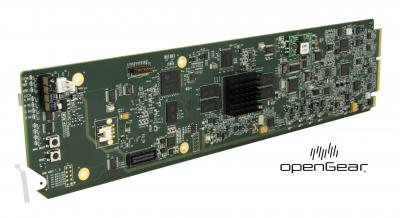 The Cobalt® 9922-FS 3G/HD/SD-SDI Frame Sync with Audio/Video Processing, AES/Analog Audio Embedding/De-Embedding, and CVBS I/O offers frame sync, and advanced audio and ancillary data support, plus many other powerful features. Frame sync can select from multiple reference inputs, with failover to alternate selected sources. Full audio support includes per-channel audio delay. Option +2FS adds a second independent processing path, offering two signal paths on a single openGear® card, with both paths providing independent frame sync and audio embedding /de-embedding.
The Cobalt® 9922-FS 3G/HD/SD-SDI Frame Sync with Audio/Video Processing, AES/Analog Audio Embedding/De-Embedding, and CVBS I/O offers frame sync, and advanced audio and ancillary data support, plus many other powerful features. Frame sync can select from multiple reference inputs, with failover to alternate selected sources. Full audio support includes per-channel audio delay. Option +2FS adds a second independent processing path, offering two signal paths on a single openGear® card, with both paths providing independent frame sync and audio embedding /de-embedding.
Advanced frame sync features include per-channel audio delay, audio/video offset, and output rate conversion to and from 23.98/29.97/29.94 to 24/30/60 frame rates. Frame sync can select from multiple reference inputs, with failover to alternate selected sources.
Audio embed adaptive SRC allows asynchronous 48 kHz AES audio to automatically sync with program video 48 kHz timing for glitch-free embedding. Individual, per-pair SRC auto-detects and disables SRC when a Dolby pair is detected on an input pair. Bulk and per-channel audio delay controls easily address lip-sync issues.
Option +TTS provides high-quality Text-To-Speech synthesis, directly converting EAS text to digital audio speech with no baseband signal breakouts or add-ons. It interfaces with industry standard Windows Share folder systems to receive non-proprietary text, XML, or similar plain text files, and converts and inserts realistic human-voice audio into user-configured audio channels. Option +EASprovides the ideal solution for keying Emergency Alert System (EAS) textcrawls in the active video. Option +EAS directly converts serial crawl text datafrom EAS generators (such as Sage™ or Dasdec™) to a keyed scrolling text insertion. User-configurable fill background color and text size can be correlated to event severity. Option +EAS provides EAS crawl burn-ins directly from industry standard EAS devices such as Sage™.
With option +ANC, the 9922-FS offers full VANC/HANC ancillary data packet de-embedding and embedding to and from external serial and IP interfaces.
A convenient input crosspoint with RP168 clean switching can select from up to four SDI inputs. The input crosspoint allows manual selection of input via remote control or GPIO, or failover to alternate inputs on loss of input conditions. Two discrete character burn strings can be inserted on output video, with each string inserted as static text and/or insert only upon LOS. With option +T-SLATE, import of user trouble slate graphics is also supported in addition to standard test pattern insert as an input LOS/quality event marker. A moving-box insertion can serve as a dynamic raster confidence check even when the input video image is static. Included standard is closed captioning absence/presence detection for CEA 608/708 and line 21 SD closed captioning.
Preset save/load allows saving custom card settings while allowing one-button revert to factory settings. Layered presets allow invoking changes related only to a specific area of concern (audio routing, for example) while not changing any other processing settings or aspects. Full user DashBoard™ or Remote Control Panel remote control allows full status and control access locally or across a standard Ethernet network. GPIO allows direct input routing control and status monitoring.

